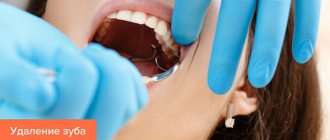After the removal of a wisdom tooth, negative symptoms may appear in the form of swelling, pain, fever, etc. Removing a wisdom tooth is a painful procedure. As a rule, they are caused by the complexity of the dental procedure and go away on their own. However, in some cases, this is a sign of serious pathological processes requiring medical intervention.
What manifestations are observed after the removal of a wisdom tooth is important information for a person who requires this type of operation.
Reasons why the cheek swells after tooth extraction
After tooth extraction, an inflammatory process occurs in the soft tissues of the oral cavity - this is the main cause of edema and swelling. If the operation is performed correctly and the patient has followed all the dentist’s recommendations, the non-infectious inflammation will go away on its own, without antibiotics or complications, and along with it, pain and swelling will go away.
The duration of swelling varies depending on the surgical technique, which tooth was removed, the condition of the oral cavity, and finally, the physical condition of the patient and his immune system. On average, swelling lasts 3-4 days, but can last for 7 days. If after a week the swelling has not subsided, this is a sign of the development of complications and a reason to consult a specialist.
Swelling appears a few hours after surgery (after the anesthesia wears off). At the same time, the patient may feel aching pain, and ichor is released from the wound. A slight increase in temperature is allowed. All these symptoms are considered natural and do not pose any danger. And to relieve pain, you can take painkillers analgesics.
Maximum swelling is recorded on days 3-4, from this moment it begins to decrease and by the seventh day it completely disappears. But the cheek can swell immediately after depulpation; this happens if the patient had gumboil and the tumor developed even before the operation.
The wound is bleeding
In dental practice, there is only one known case in which a patient died after the removal of three adjacent teeth. The cause of death was not blood loss at all. The patient could not think of anything better after the operation than to drink a fair amount of alcohol and go to bed. Alcoholic drinks affect the liver, which increases bleeding. Due to alcohol intoxication, the sleep was sound, blood entered the respiratory tract, and the poor man choked.
In any case of bleeding due to an extracted tooth, the patient should calm down.
You only need to seek medical help in one case, if blood flows out of the wound in a stream.
If the patient is worried about bleeding, it is enough to make a tampon from sterile material and press it with your teeth to the wound for half an hour. If necessary, the doctor will prescribe special medications to stop bleeding. Doctors do not recommend using hydrogen peroxide in such cases.
If bleeding continues for more than a day, this is a symptom of a complication. Only a dentist, upon examination, will determine the cause of these complications and prescribe further treatment.
Cheek swelling during wisdom tooth removal
Extraction of extreme molars (wisdom teeth) is considered one of the most difficult tooth extraction operations. It is accompanied by an incision of soft tissues and suturing, so inflammation after it is inevitable. Swelling after wisdom teeth removal lasts longer and is accompanied by pain.
Moreover, an elevated temperature may persist for several days, the patient may have difficulty swallowing, and experience pain when opening the mouth and during speech.
In this case, there is a risk of infection and serious inflammation, therefore, after depulping the extreme molars, it is necessary to take antibiotics and rinse the mouth with antiseptic solutions.
A growth has formed on the gum
After tooth extraction, there is often a complication such as the appearance of a lump on the gum. A growth in such a place indicates the onset of dangerous inflammatory complications. An infection can be caused if the clot is removed carelessly. Another source of infection is leftover food, so dentists prohibit patients from eating for several hours after surgery. During this time, a clot should form in the wound, protecting the gums from infection.
If a growth has formed on the gum, it may be an allergy to the anesthetics used or mechanical damage. Often a growth forms where the injection was given; such a new growth contains liquid inside, which in its structure is no different from a hematoma.
Such a lump will resolve in three days, unlike an infectious one, which often does not go away on its own and requires treatment.
Inside the growth, which is infectious in nature, there are purulent masses.
To determine the nature of the lump, the dentist performs palpation. By palpation, the doctor determines how hard the lump is and whether it contains liquid and pus inside. To make an accurate diagnosis, an x-ray or computed tomography may be prescribed. X-rays are not prescribed to pregnant patients. Based on the diagnostic results, the most appropriate treatment for the growth is prescribed.
- If there is no clot in the hole, it is cleared of inflamed tissues and treated with antiseptic materials. At the end of the manipulation, a hemostatic sponge is placed in the hole.
- The surgeon may decide to open the lump with a surgical instrument. After the procedure, the patient is invited to return for a follow-up visit in a few days.
- The general method of treating and preventing the growth is to take certain antibiotics.
Before coming to the dentist, the patient can rinse his mouth with furatsilin solution on his own. This drug cannot affect the size of the growth, but it will have an antimicrobial effect and reduce the intensity of inflammation. You can use dental ointments with an antibacterial effect. Folk remedies will not help get rid of the growth, but they can provide short-term relief. For this, soda and salt solutions are used. Rinsing should not be too vigorous, so as not to remove a blood clot that is beneficial for the body from the socket.
Other causes of cheek swelling
Along with natural, so-called non-infectious inflammation, there are other causes of cheek swelling:
- tooth extraction due to gumboil;
- extraction with complications - in case of incorrect inclination or direction of tooth growth, when removing massive teeth and teeth with long roots;
- the presence of infection and inflammation in soft tissues;
- allergic reaction to medications or anesthesia;
- individual intolerance to components in medications or anesthetics;
- errors during extraction, insufficient antiseptic treatment of the oral cavity and residual infection;
- the presence of chronic diseases – hypertension, neuralgia, psycho-emotional pathologies;
- failure by the patient to comply with the recommendations of the dental surgeon, refusal of prescribed antibiotics or reduction of their dosage.
Most often, the tumor is caused by improper oral care, lack of disinfection with antiseptics, and skipping medications.
In what cases are molars removed?
Medical indications for extraction are:
- Progressive odontogenic osteomyelitis of the jaw. It is a purulent infectious-inflammatory lesion that affects not only the root of the molar, but also the tissue adjacent to it. Leads to increased body temperature, weakness, and abscess. For osteomyelitis of this type, tearing out the “causal” unit should be done in line order. Under no circumstances should surgery be postponed. Otherwise, the pathological contents of the abnormal focus will be evacuated into the jaw bone. There is a possibility of it entering the systemic circulation.
- Purulent periostitis, phlegmon, abscess, lymphadenitis, sinusitis of the maxillary sinus , if it is impossible to ensure a high-quality outflow of purulent masses from the infectious focus in the jaw.
- Lack of effect after conservative therapy for any purulent-inflammatory lesions of the oral cavity.
- Complete destruction of the crown and unsuitability of the remaining roots for prosthetics. Damaged root canals are a chronic source of odontogenic infection, so they have to be disposed of.
- The presence of teeth in the area of fracture of the alveolar process or jaw bone. Such units do not allow the correct composition of bone fragments and are regarded as conduits for infection.
- Impacted units, during the eruption of which a strong infectious-inflammatory reaction , tumor or cyst developed.
- Fangs, incisors and molars, due to which the mucous membranes of the mouth are constantly injured. They can be pulled out if standard sanding does not stabilize the situation.
- Progressive periodontitis , if loosening has reached the third or fourth stage.
- of a malignant tumor in the tissues of the periodontium or alveolar process
- Severe malocclusions , when “neighbors” do not allow the aligned units to take the correct position.
- Supernumerary teeth , causing curvature of the row, disrupting the aesthetics of the face.
Possible complications
If after seven days the tumor not only has not gone away, but has also grown and become denser, this indicates a progressive inflammatory process.
At the same time, other symptoms may appear: pain in the gums and cheeks (aching, cutting, throbbing), redness of the cheeks and gums, fever, weakness, loss of appetite, headache.
What complications can inflammation lead to:
- Alveolitis or “dry socket” - after a tooth is removed, a blood clot forms in the resulting socket. It serves as a protection and barrier to bacteria and protects the wound from infection. If it is somehow removed, the soft tissues are left without protection, pathogenic bacteria penetrate into them and suppuration begins. In advanced cases, inflammation spreads to other areas of the jaw; not only the cheek, but also the cheekbones and even the eye area swell.
- If, in addition to the tumor, the patient experiences severe pain in the jaw, this may indicate the development of osteomyelitis - inflammation of the bone tissue. The swelling on the cheek grows, spreading to the cheekbones and other parts of the face, the pain spreads to both jaws, the patient experiences pain when opening the mouth. If you do not consult a specialist in time, the disease can lead to blood poisoning.
- A gum abscess is a purulent inflammation inside the gum tissue. It is dangerous due to the spread of inflammation to other tissues, loosening and loss of teeth.
- Periostitis of the jaw (flux) is an inflammation of the jaw, characterized by increased temperature and severe pain in the jaw and temporal part. If left untreated, the flux can spread to the infraorbital area. In chronic form it can develop into osteomyelitis.
- Neuritis is damage to the facial nerve, accompanied by severe pain and swelling. A distinctive symptom is swelling of the larynx, palate, tongue, and cheeks.
Each of these complications can cause serious consequences, which is why it is so important to diagnose and treat in a timely manner.
Gums hurt
Often, after tooth extraction, the patient's gums hurt. Experts are confident that this is a natural reaction of the body to surgical trauma. In this case, the pain is moderate, but sometimes it indicates not only gum injury, but also inflammation. Medical statistics note that inflammation after tooth extraction occurs in 4% of operations. Gum pain as a result of inflammation becomes even more likely if not just one, but several hours of removal. How to determine whether a wound is healing? How to act in case of inflammation?
Normally, after a tooth is removed, a clot of dark blood forms in the socket, which over time acquires a white-yellow hue.
The duration of the pain depends on the level of injury and the appearance of inflammation; it usually hurts for no more than two days. The pain is much more serious if the inert tissue is severely damaged, which inevitably happens when cutting out bone using a bore. This surgical technique is used when it is necessary to remove a crown or extract a tooth in parts. In all other cases, prolonged pain indicates a medical error or problems in the body.
To relieve pain, the use of analgesics is allowed. Normally, they help a lot, but if the pill doesn’t work, this is evidence that the operation was performed incorrectly. Medical errors during tooth extraction occur frequently, especially in the following cases.
- When sawing out bone using a drill. Modern dental standards require the use of drill tips with a cooling component. But in domestic dentistry, most dentists use tips without cooling. As a result, the patient receives a burn, as a result of which superficial necrosis develops, accompanied by acute pain. If the pain does not go away after using NSAIDs, and a blood clot does not form in the socket, you will have to go to the doctor again. The doctor will clean the hole from dead tissue, after this manipulation the patient’s condition will return to normal.
- If there are sharp bones protruding from the socket. Such edges of protruding bones often injure the mucous membrane, especially if the bone is not completely covered by a clot in the socket. Most often, this problem occurs due to the fault of the surgeon who did not apply stitches to close the wound. The patient can independently determine the presence of cutting fragments by touching the tongue, as well as in case of severe pain when drinking drinks. In rare cases, bone fragments can be seen when examining the wound in the mirror.
- With mobility of parts of the bone in the wound. Sometimes the dentist does not notice significant pieces of bone that were formed when the tooth was rocked. Such pieces often cause pain and inflammation in the socket. The problem can only be corrected with a second visit to the dentist.
- Incorrect removal method. This is a common cause of complications after tooth extraction. Dentists have different experiences, so two doctors remove the same tooth in different ways. So, when removing, you can use forceps, but another doctor, to speed up the process, will divide the tooth into two halves and only then remove them.
- Excessive use of anesthetic, leading to spasm of the blood vessels of the gums. As a result of such an error, the hole after the operation does not fill with blood and a clot does not form. In an empty socket, the bone is exposed and reacts painfully to touch.
- The dentist did not apply stitches, which should be done even when removing some teeth with a single root. In the case of teeth with several roots, a suture is required in the vast majority of cases. A properly sutured wound reduces the intensity of pain and the likelihood of complications by half. With stitches, the wound heals much faster.
- The dentist did not prescribe antibiotics. These drugs are not always prescribed, but in difficult cases, inflammation and acute pain cannot be avoided without them.
Do not start taking medications without discussing with your doctor, relying on the recommendations of friends or the Internet. The pain normally lasts no longer than a couple of days and should be moderate. If the pain does not subside, bone particles are felt in the hole, the wound reacts to liquid, or an unpleasant taste appears in the mouth, you should immediately contact the dentist who performed the operation or any other similar specialist.
How to eliminate cheek swelling
It is impossible to completely remove the tumor until the inflammatory process stops, but you can reduce it and minimize discomfort and pain. This can be done with ice and cold compresses. You need to apply a compress every half hour, but no longer than 10-15 minutes, otherwise it can cause hypothermia and tissue necrosis.
In addition, you can drink painkillers, analgesics, take baths and rinses with an antiseptic solution. Take antibiotics if prescribed by your doctor. This will eliminate the infection and speed up tissue healing.
In general, swelling of the cheek is a normal phenomenon if it occurs a couple of hours after tooth extraction and goes away no later than the seventh day after it. In all other cases, immediate specialist consultation, diagnosis and treatment are required.
What happens if you don’t treat a lump after a tooth extraction?
There are two options here:
- the neoplasm will resolve on its own within three to five days;
- the inflammatory process will progress and the situation will worsen.
Should we hope for a favorable outcome without medical help? Of course it is possible. Moreover, this is what happens in most cases. However, the risk of refusing to receive medical advice is always large and unfounded. There is no need to expect that the lump will resolve on its own. Having received medical advice, a person avoids many troubles.
If the doctor determines that the tumor does not pose a threat to health and is a normal variant, he will simply tell you to wait. If the diagnosis shows the presence of a dental disease, it will be treated. In both cases, the patient will benefit - he will maintain the health of his smile and avoid complications dangerous to the body.
Take care of yourself and don’t let dental problems take their course. Otherwise, very soon you will need prosthetics or implantation.










